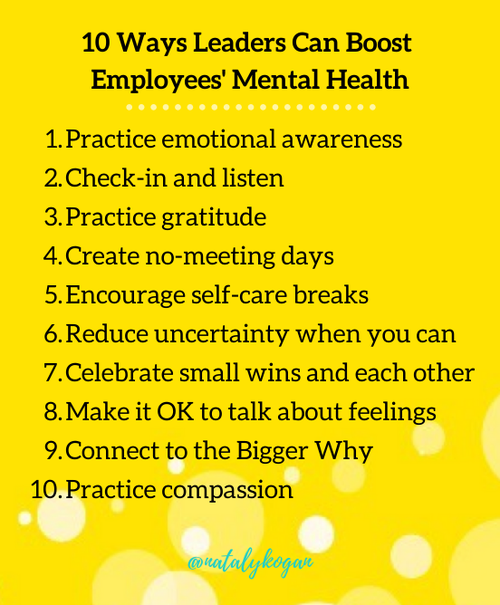
10 Practical Science-Backed Ways Leaders Can Support Their Employees’ Mental Health During Challenges
Happier.com | BY NATALY KOGAN | Mental Health | Health Insurance
As a leader, your job is not to manage people or projects — it’s to manage mental health, including your own.
During this really challenging time (understatement of the year!) that can be really intense and since we don’t learn about emotional fitness skills in MBA or leadership development programs, you don’t always know what to do.
The first thing you can do is make your and your team’s emotional and mental health your number one priority. You can’t give what you don’t have and your team members can’t give what they don’t have. If everyone is depleted and overwhelmed, it doesn’t matter how many motivating talks you give. As mountains of research show, we can’t do great work unless we fuel our well-being first.
Since the pandemic broke out, I’ve done 100+ virtual sessions on emotional fitness skills for teams and leaders and have led 3 virtual leadership development groups, to help leaders bring their full capacity to the challenges they are facing right now — and help people they lead do the same.
Here are my 10 favorite science-backed tips to help you strengthen the emotional and mental health of people you lead — starting with your own.

1. Practice emotional awareness and openness
Whether you like it or not, as a leader, your emotions have an amplified effect on everyone else. So begin by practicing emotional awareness: Check in with yourself by asking “How am I feeling? What is my energy like?” (Do this first thing in the morning and before meetings.)
When your emotions vary from the norm (upset, stressed, more tense than usual) acknowledge them openly by telling people a little bit about why you feel that way. You don’t need to write a novel about your feelings — just share enough so the other person knows what’s up. This reduces stress and wasted energy for people trying to guess why you’re acting differently and gives them permission to share their emotions more openly.
2. Check-in and listen
Be intentional about checking in with your colleagues one on one to ask them how they are doing. This practice has 2 steps: (1) Ask them how they are and then (2) listen, giving them your full attention, without multi-tasking or trying to fix or give advice. During this challenging time when everyone feels more isolated, checking in with others is a powerful way to create moments of genuine human connection. (And no, you don’t always need to do it on Zoom — scheduling a quick check-in call works great!)
3. Practice Gratitude
During challenges and difficulties, the human brain’s natural negativity bias — being more sensitive to what’s wrong or negative — is in overdrive, making it easy to become overwhelmed with negative thoughts and even hopelessness. Practicing gratitude openly is the best way to counter the negativity spiral.
Add Gratitude Bookends to your meetings: Begin a meeting by sharing something specific you’re grateful for or expressing your gratitude for someone else and at the end of the meeting, ask someone to do the same. This simple practice elevates the importance of gratitude for your team, encourages people to practice it on their own, and makes meetings more productive and collaborative.



























































